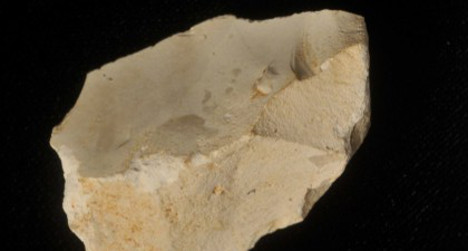1.4 million-year-old flint blade unearthed in Spain

Archaeologists said on Wednesday they have found a flint blade dating back 1.4 million years in the caves of Atapuerca in Spain, the earliest sign of a human presence at the site.
The three-centimetre (1.2-inch) blade was found in the so-called Elephant Chasm cave where in 2007 researchers found a human finger and jawbone dating back 1.2 million years — considered the remains of the “oldest European” ever found.
The find made this year, considered to be “of great value”, came from a carving knife, Eduald Carbonell, one of the directors of the dig, said during a presentation of the discovery.
The site, near the northern city of Burgos, has been under excavation since 1978. In 2000 it was classed by UNESCO as a piece of world heritage.
The oldest parts of the site are one and a half million years old.
Stone tools discovered in this site confirm the continuity of human settlement in Europe, the researchers said.  Photo:JORDI MESTRE / EIA / AFP The finding contradicts the theory of some researchers who believe Europe was populated in small waves without continuity by groups doomed to extinction because of their inability to adapt to new surroundings, they said in their statement. “Even though they are very archaic tools, they reflect complex activities such as recovering animals that fell into the caves,” which functioned as traps, the statement said.
Photo:JORDI MESTRE / EIA / AFP The finding contradicts the theory of some researchers who believe Europe was populated in small waves without continuity by groups doomed to extinction because of their inability to adapt to new surroundings, they said in their statement. “Even though they are very archaic tools, they reflect complex activities such as recovering animals that fell into the caves,” which functioned as traps, the statement said.
Researchers have also found the remains of a large bear which is an ancestor to the brown bear that exists today.
Various remains of this species were found at the site, as well as those of other animals such as rhinos, giant deer, bison and wild donkeys.
During the current digging season at the site, which just wrapped up, archaeologists presented another rare item they discovered — a fossilized shoulder blade of a child between the ages of four and six dating back 800,000 years.
It was discovered in 2005, but since it was trapped in a block of calcified clay it took seven years of work to extract.
Comments
See Also
The three-centimetre (1.2-inch) blade was found in the so-called Elephant Chasm cave where in 2007 researchers found a human finger and jawbone dating back 1.2 million years — considered the remains of the “oldest European” ever found.
The find made this year, considered to be “of great value”, came from a carving knife, Eduald Carbonell, one of the directors of the dig, said during a presentation of the discovery.
The site, near the northern city of Burgos, has been under excavation since 1978. In 2000 it was classed by UNESCO as a piece of world heritage.
The oldest parts of the site are one and a half million years old.
Stone tools discovered in this site confirm the continuity of human settlement in Europe, the researchers said.
The find made this year, considered to be “of great value”, came from a carving knife, Eduald Carbonell, one of the directors of the dig, said during a presentation of the discovery.
The site, near the northern city of Burgos, has been under excavation since 1978. In 2000 it was classed by UNESCO as a piece of world heritage.
The oldest parts of the site are one and a half million years old.
Stone tools discovered in this site confirm the continuity of human settlement in Europe, the researchers said.

Photo:JORDI MESTRE / EIA / AFP
The finding contradicts the theory of some researchers who believe Europe was populated in small waves without continuity by groups doomed to extinction because of their inability to adapt to new surroundings, they said in their statement.
“Even though they are very archaic tools, they reflect complex activities such as recovering animals that fell into the caves,” which functioned as traps, the statement said.
Researchers have also found the remains of a large bear which is an ancestor to the brown bear that exists today.
Various remains of this species were found at the site, as well as those of other animals such as rhinos, giant deer, bison and wild donkeys.
During the current digging season at the site, which just wrapped up, archaeologists presented another rare item they discovered — a fossilized shoulder blade of a child between the ages of four and six dating back 800,000 years.
It was discovered in 2005, but since it was trapped in a block of calcified clay it took seven years of work to extract.
Researchers have also found the remains of a large bear which is an ancestor to the brown bear that exists today.
Various remains of this species were found at the site, as well as those of other animals such as rhinos, giant deer, bison and wild donkeys.
During the current digging season at the site, which just wrapped up, archaeologists presented another rare item they discovered — a fossilized shoulder blade of a child between the ages of four and six dating back 800,000 years.
It was discovered in 2005, but since it was trapped in a block of calcified clay it took seven years of work to extract.
Join the conversation in our comments section below. Share your own views and experience and if you have a question or suggestion for our journalists then email us at [email protected].
Please keep comments civil, constructive and on topic – and make sure to read our terms of use before getting involved.
Please log in here to leave a comment.